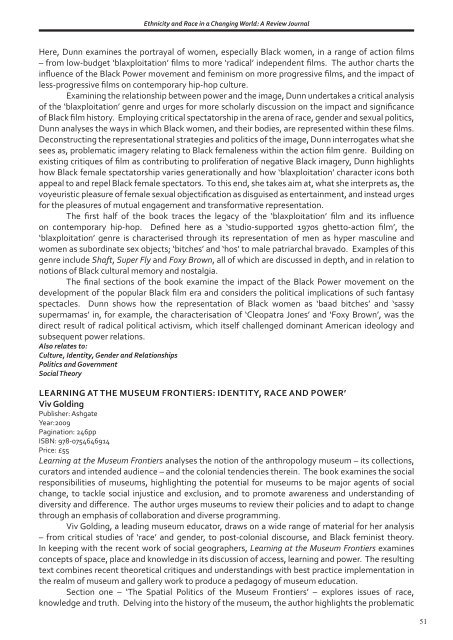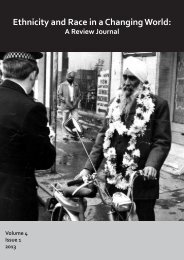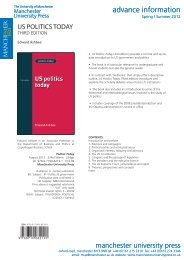Ethnicity and Race in a Changing World
Volume 2, Issue 1, 2010 - Manchester University Press
Volume 2, Issue 1, 2010 - Manchester University Press
- No tags were found...
Create successful ePaper yourself
Turn your PDF publications into a flip-book with our unique Google optimized e-Paper software.
<strong>Ethnicity</strong> <strong>and</strong> <strong>Race</strong> <strong>in</strong> a Chang<strong>in</strong>g <strong>World</strong>: A Review JournalHere, Dunn exam<strong>in</strong>es the portrayal of women, especially Black women, <strong>in</strong> a range of action films– from low-budget ‘blaxploitation’ films to more ‘radical’ <strong>in</strong>dependent films. The author charts the<strong>in</strong>fluence of the Black Power movement <strong>and</strong> fem<strong>in</strong>ism on more progressive films, <strong>and</strong> the impact ofless-progressive films on contemporary hip-hop culture.Exam<strong>in</strong><strong>in</strong>g the relationship between power <strong>and</strong> the image, Dunn undertakes a critical analysisof the ‘blaxploitation’ genre <strong>and</strong> urges for more scholarly discussion on the impact <strong>and</strong> significanceof Black film history. Employ<strong>in</strong>g critical spectatorship <strong>in</strong> the arena of race, gender <strong>and</strong> sexual politics,Dunn analyses the ways <strong>in</strong> which Black women, <strong>and</strong> their bodies, are represented with<strong>in</strong> these films.Deconstruct<strong>in</strong>g the representational strategies <strong>and</strong> politics of the image, Dunn <strong>in</strong>terrogates what shesees as, problematic imagery relat<strong>in</strong>g to Black femaleness with<strong>in</strong> the action film genre. Build<strong>in</strong>g onexist<strong>in</strong>g critiques of film as contribut<strong>in</strong>g to proliferation of negative Black imagery, Dunn highlightshow Black female spectatorship varies generationally <strong>and</strong> how ‘blaxploitation’ character icons bothappeal to <strong>and</strong> repel Black female spectators. To this end, she takes aim at, what she <strong>in</strong>terprets as, thevoyeuristic pleasure of female sexual objectification as disguised as enterta<strong>in</strong>ment, <strong>and</strong> <strong>in</strong>stead urgesfor the pleasures of mutual engagement <strong>and</strong> transformative representation.The first half of the book traces the legacy of the ‘blaxploitation’ film <strong>and</strong> its <strong>in</strong>fluenceon contemporary hip-hop. Def<strong>in</strong>ed here as a ‘studio-supported 1970s ghetto-action film’, the‘blaxploitation’ genre is characterised through its representation of men as hyper mascul<strong>in</strong>e <strong>and</strong>women as subord<strong>in</strong>ate sex objects; ‘bitches’ <strong>and</strong> ‘hos’ to male patriarchal bravado. Examples of thisgenre <strong>in</strong>clude Shaft, Super Fly <strong>and</strong> Foxy Brown, all of which are discussed <strong>in</strong> depth, <strong>and</strong> <strong>in</strong> relation tonotions of Black cultural memory <strong>and</strong> nostalgia.The f<strong>in</strong>al sections of the book exam<strong>in</strong>e the impact of the Black Power movement on thedevelopment of the popular Black film era <strong>and</strong> considers the political implications of such fantasyspectacles. Dunn shows how the representation of Black women as ‘baad bitches’ <strong>and</strong> ‘sassysupermamas’ <strong>in</strong>, for example, the characterisation of ‘Cleopatra Jones’ <strong>and</strong> ‘Foxy Brown’, was thedirect result of radical political activism, which itself challenged dom<strong>in</strong>ant American ideology <strong>and</strong>subsequent power relations.Also relates to:Culture, Identity, Gender <strong>and</strong> RelationshipsPolitics <strong>and</strong> GovernmentSocial TheoryLEARNING AT THE MUSEUM FRONTIERS: IDENTITY, RACE AND POWER’Viv Gold<strong>in</strong>gPublisher: AshgateYear:2009Pag<strong>in</strong>ation: 246ppISBN: 978-0754646914Price: £55Learn<strong>in</strong>g at the Museum Frontiers analyses the notion of the anthropology museum – its collections,curators <strong>and</strong> <strong>in</strong>tended audience – <strong>and</strong> the colonial tendencies there<strong>in</strong>. The book exam<strong>in</strong>es the socialresponsibilities of museums, highlight<strong>in</strong>g the potential for museums to be major agents of socialchange, to tackle social <strong>in</strong>justice <strong>and</strong> exclusion, <strong>and</strong> to promote awareness <strong>and</strong> underst<strong>and</strong><strong>in</strong>g ofdiversity <strong>and</strong> difference. The author urges museums to review their policies <strong>and</strong> to adapt to changethrough an emphasis of collaboration <strong>and</strong> diverse programm<strong>in</strong>g.Viv Gold<strong>in</strong>g, a lead<strong>in</strong>g museum educator, draws on a wide range of material for her analysis– from critical studies of ‘race’ <strong>and</strong> gender, to post-colonial discourse, <strong>and</strong> Black fem<strong>in</strong>ist theory.In keep<strong>in</strong>g with the recent work of social geographers, Learn<strong>in</strong>g at the Museum Frontiers exam<strong>in</strong>esconcepts of space, place <strong>and</strong> knowledge <strong>in</strong> its discussion of access, learn<strong>in</strong>g <strong>and</strong> power. The result<strong>in</strong>gtext comb<strong>in</strong>es recent theoretical critiques <strong>and</strong> underst<strong>and</strong><strong>in</strong>gs with best practice implementation <strong>in</strong>the realm of museum <strong>and</strong> gallery work to produce a pedagogy of museum education.Section one – ‘The Spatial Politics of the Museum Frontiers’ – explores issues of race,knowledge <strong>and</strong> truth. Delv<strong>in</strong>g <strong>in</strong>to the history of the museum, the author highlights the problematic51






